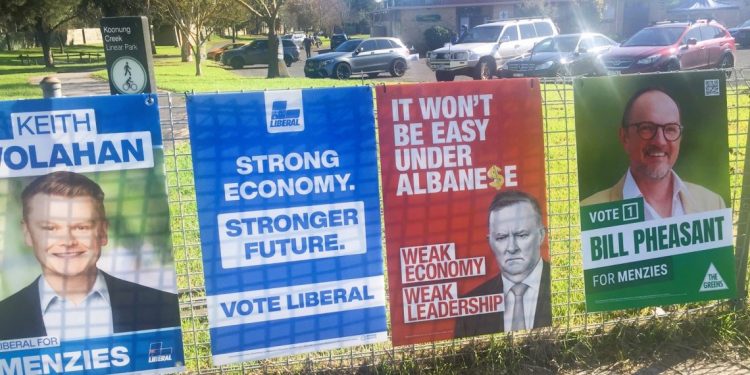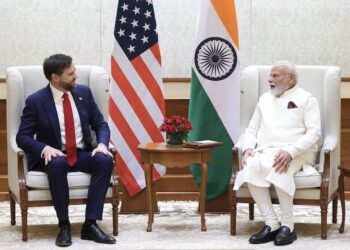Prior to the May 21 election, there was intense media interest in how the growing and diverse Indian diaspora in Australia would vote. In my memory, this is the first time the community was ‘courted’ so enthusiastically by both major parties, even though the campaign strategies themselves may have come across as tokenistic and outdated to some voters.
In the case of the Liberal party, there was extensive coverage of former Prime Minister Scott Morrison’s ‘friendship’ with Indian Prime Minister Narendra Modi (and associated attempts to improve bilateral relations between the countries), Morrison’s Twitter posts about cooking ‘curry’ for his family and paying homage to South Asian cultures in the process, and party candidates’ visits to Hindu and Sikh temples and small businesses to take advantage of ‘photo-ops’. The Labor party also took advantage of photo opportunities is similar cultural institutions, though it was criticised for missing a vital opportunity for fielding a local candidate from a South Asian background in the marginal seat of Parramatta when it decided to go with captain’s pick, Andrew Charlton.
As the Labor Party has emerged triumphant across the nation and Charlton has won his seat, more attention is being paid (and rightfully so) to how the Chinese-Australians voted against the Liberals. There hasn’t been a detailed analysis of how the Indian diaspora voted in several key seats, and I suspect that is because the narrative is not quite as simple as was projected prior to the election.
What is clear is that Labor won Parramatta primarily on account of large swings to it in suburbs with substantial Chinese and Asian-Australia communities, such as Carlingford towards the north of the electorate. In Indian-Australian-dominated suburbs of the seat like North Parramatta, Harris Park, Pendle Hill, Wentworthville and Westmead, there was a slight swing towards the Liberals. One is tempted to attribute this to Morrison’s courting of this community, but a closer look at other seats is the country suggests that local factors have played a significant role. It is also possible that Charlton’s pre-selection itself could have led to disaffected voters who did not have the choice to vote for a local candidate (like in Fowler), leading to favourable swings for the Greens and the Animal Justice party, amongst others. Worth noting is that in the booth of North Parramatta, for instance, there was also a 5% swing against the Liberal Candidate. Therefore, it is not as though the community was overwhelmingly ‘won over’ by the Liberals in this seat.
Despite all the media attention on Parramatta, there is a critical mass of Indian-Australia voters in neighbouring western and inner west seats like Greenway, Chifley and Reid. Some us of commenting on the election did try to draw attention to the infrastructure problems in outer urban areas with new housing developments where many new Indian migrants live (such as Schofields, Marsden Park and Box Hill), but the media remained solely focused on Parramatta. What is noteworthy about Greenway, Chifley and neighbouring McMahon is that the Liberal party fielded first-generation Indian migrant men in all three electorates which are usually safe Labor seats. Despite the Liberal candidate for Greenway, Pradeep Pathi seemingly representing the diversity of his electorate, there was a swing away from him and towards Labor’s Michelle Rowland. This includes voters in suburbs with working class and Sikh communities such as Blacktown, and others with more ‘aspirational’ values and professional backgrounds like Schofields, Stanhope Gardens and The Ponds. In fact, the swings towards Labour we see in some of these booths are almost sizeable as those towards the Liberals in booths like Wentworthville in Parramatta. It is likely that the state Liberal Government’s delays in infrastructure development and the popularity of Rowland in this seat played a part.
Another seat worth mentioning is Reid where Labor’s Sally Sitou emerged victorious. I have heard many anecdotes of South Asian-Australian voters who dominate in the suburbs of Flemington, Homebush, Homebush West and Strathfield in the seat, and who switched their vote from Liberal to Labor this election. Again, this is likely due to local issues such as over-development in parts of the electorate and to the very strong grassroots campaigning from Sitou’s team.
As I am not a resident of Victoria, my analysis of the Indian-Australian suburbs and their voting patterns there cannot reflect the same level of lived experience. However, a closer look at the suburbs or Tarneit and Werribee in the seat of Lalor suggest that there are swings against both the major parties (and towards minor parties, including the UAP) despite this being a relatively safe Labor seat. Similarly, in the electorate of Scullin, there is a strong overall swing against the Labor member, Andrew Giles of nearly 13%, as smaller swing against the Liberals and a higher percentage of votes going towards the smaller parties. This may be reflective of patterns in suburban Melbourne, particularly in new housing estates which have infrastructures issues similar to those of Greenway in NSW.
The story that is emerging about the Indian diaspora here is that it is not a clearly defined voting bloc, that local issues and campaigning matter, and that diverse representation does count when the candidate understands and represents the community’s broader interests instead of installing diverse face as a tokenistic gesture.











